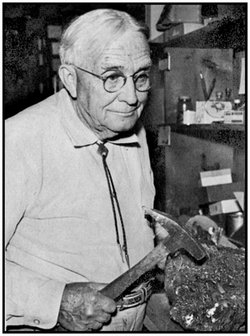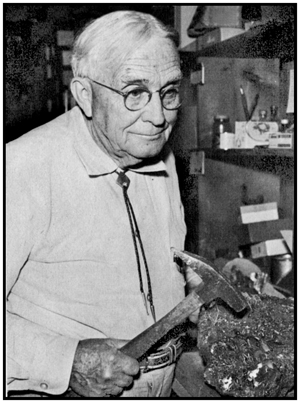Arthur L. Flagg (1892-1961)
Arthur Leonard Flagg was born in Woonsocket, Rhode Island on June 29, 1882, the son of Anna and Charles Flagg, a jeweler. At an early age he developed an interest in minerals through people he met in his father's jewelry store.
Flagg, a Quaker, was Class President, Salutatorian and Editor-in-Chief of the class yearbook at the Friends (High) School in Providence, where he graduated in 1902. While still a young man he had decided he wanted to make minerals his life's work; consequently he enrolled at Brown University in Providence to study Mining Engineering, Geology and Mineralogy. During his term as a student there, the building housing the college's mineral collection was twice destroyed by fire. Flagg was one of the students assigned to examine, clean, and re-identify the specimens that had been salvaged. This gave him the chance to handle a large variety of minerals and develop some skill at recognizing and identifying the different species. He was also involved in geologic work on several quadrangle surveys being carried out in the Bradshaw Mountains of Central Arizona. This work inspired an interest in Arizona, its geology, mines and minerals; and thus, soon after graduation in 1906, he headed for the Arizona hills.
Flagg then returned home to Rhode Island where he married Mary H. White (1884-1979) in 1910 and they settled there for a while; their son Edward was born there in 1912. But by 1918 he was back in Arizona again, working as a mining engineer for the Kelvin Sultana Copper Company in Kelvin. His career in mining and mineralogy lasted for more than 55 years, nearly all of which was spent in Arizona.
Arthur Flagg possessed a connoisseur's eye for beautiful mineral specimens and a contagious enthusiasm that interested others in the fun of mineral collecting. He especially enjoyed teaching children and young people about the economic importance of mineral deposits as well as the joys of mineral collecting. Over the years he gave away thousands of mineral specimens to rockhounds and potential mineral collectors young and old. At every meeting of the Mineralogical Society of Arizona, he would hand out carefully wrapped specimens to members, especially juniors. These were passed out quietly, as he never sought public recognition of his generosity. The specimens he gave out (probably self-collected) were of a size and quality to fit each collector's particular interests and level of advancement.
Few mineralogists or collectors could sight-identify hand specimens as rapidly and accurately as could Arthur Flagg. On one occasion he was asked to identify a number of mineral specimens from one of the nearby colleges. An assistant would unwrap each specimen one at a time, then take a couple of steps and hand it to Flagg. While the assistant was taking those steps, Flagg would sometimes announced the name of the mineral, the name of the discoverer, the name and location of the mine that first reported it, the year of its identification, the principal chemical contents and the technical paper reporting its discovery. All while the specimen was still several feet away.
During Flagg's association with the Arizona Department of Mineral Resources, hundreds of rockhounds and propspectors would bring in specimens and ore samples for him to identify. He must have heard "What-is-this-stuff?" many thousands of times. But he knew Arizona minerals, mines and locations so well that he was rarely stumped and could usually recognize at least the mining district and sometimes also the particular mine where the specimen had been found.
Arthur Flagg was well known in Arizona mining circles and was always generous with his time and knowledge. He was a founder and active member of several mining and mineralogical groups, including the the Mineralogical Society of Arizona, the Small Mine Operators Association, the American Federation of Mineralogical Societies, and the Rocky Mountain Federation of Mineralogical Societies. He served as President of each of those organizations, for several terms in some cases. During his 24 years as a member of the Mineralogical Society of Arizona, he is said to have missed only one or two meetings.
Flagg was affectionately known throughout the country as "Mr. Rockhound" - a well-deserved title. He published two books for mineral collectors, Rockhounds and Arizona Minerals (1944) and Mineralogical Journeys in Arizona (1958), and he wrote several articles on minerals for Arizona Highways and Rocks & Minerals, as well as professional papers published in the Bulletin of the American Institute of Mining Engineers. Flagg had dreamed of seeing an Earth Sciences Museum established in Arizona, and was the first curator of the Arizona Mineral Museum.
[The above text, with minor additions, was derived primarily from Getsinger (1965).]
References:
GETSINGER, F.R. (1965) The Woolery mineral collection. Arizona Highways, 41 (5), 29-37.
US Federal Census, 1880, 1920, 1930.
FRIENDS SCHOOL (1902) Phoenix Echo Yearbook.
Arthur L. Flagg (1892-1961)
Arthur Leonard Flagg was born in Woonsocket, Rhode Island on June 29, 1882, the son of Anna and Charles Flagg, a jeweler. At an early age he developed an interest in minerals through people he met in his father's jewelry store.
Flagg, a Quaker, was Class President, Salutatorian and Editor-in-Chief of the class yearbook at the Friends (High) School in Providence, where he graduated in 1902. While still a young man he had decided he wanted to make minerals his life's work; consequently he enrolled at Brown University in Providence to study Mining Engineering, Geology and Mineralogy. During his term as a student there, the building housing the college's mineral collection was twice destroyed by fire. Flagg was one of the students assigned to examine, clean, and re-identify the specimens that had been salvaged. This gave him the chance to handle a large variety of minerals and develop some skill at recognizing and identifying the different species. He was also involved in geologic work on several quadrangle surveys being carried out in the Bradshaw Mountains of Central Arizona. This work inspired an interest in Arizona, its geology, mines and minerals; and thus, soon after graduation in 1906, he headed for the Arizona hills.
Flagg then returned home to Rhode Island where he married Mary H. White (1884-1979) in 1910 and they settled there for a while; their son Edward was born there in 1912. But by 1918 he was back in Arizona again, working as a mining engineer for the Kelvin Sultana Copper Company in Kelvin. His career in mining and mineralogy lasted for more than 55 years, nearly all of which was spent in Arizona.
Arthur Flagg possessed a connoisseur's eye for beautiful mineral specimens and a contagious enthusiasm that interested others in the fun of mineral collecting. He especially enjoyed teaching children and young people about the economic importance of mineral deposits as well as the joys of mineral collecting. Over the years he gave away thousands of mineral specimens to rockhounds and potential mineral collectors young and old. At every meeting of the Mineralogical Society of Arizona, he would hand out carefully wrapped specimens to members, especially juniors. These were passed out quietly, as he never sought public recognition of his generosity. The specimens he gave out (probably self-collected) were of a size and quality to fit each collector's particular interests and level of advancement.
Few mineralogists or collectors could sight-identify hand specimens as rapidly and accurately as could Arthur Flagg. On one occasion he was asked to identify a number of mineral specimens from one of the nearby colleges. An assistant would unwrap each specimen one at a time, then take a couple of steps and hand it to Flagg. While the assistant was taking those steps, Flagg would sometimes announced the name of the mineral, the name of the discoverer, the name and location of the mine that first reported it, the year of its identification, the principal chemical contents and the technical paper reporting its discovery. All while the specimen was still several feet away.
During Flagg's association with the Arizona Department of Mineral Resources, hundreds of rockhounds and propspectors would bring in specimens and ore samples for him to identify. He must have heard "What-is-this-stuff?" many thousands of times. But he knew Arizona minerals, mines and locations so well that he was rarely stumped and could usually recognize at least the mining district and sometimes also the particular mine where the specimen had been found.
Arthur Flagg was well known in Arizona mining circles and was always generous with his time and knowledge. He was a founder and active member of several mining and mineralogical groups, including the the Mineralogical Society of Arizona, the Small Mine Operators Association, the American Federation of Mineralogical Societies, and the Rocky Mountain Federation of Mineralogical Societies. He served as President of each of those organizations, for several terms in some cases. During his 24 years as a member of the Mineralogical Society of Arizona, he is said to have missed only one or two meetings.
Flagg was affectionately known throughout the country as "Mr. Rockhound" - a well-deserved title. He published two books for mineral collectors, Rockhounds and Arizona Minerals (1944) and Mineralogical Journeys in Arizona (1958), and he wrote several articles on minerals for Arizona Highways and Rocks & Minerals, as well as professional papers published in the Bulletin of the American Institute of Mining Engineers. Flagg had dreamed of seeing an Earth Sciences Museum established in Arizona, and was the first curator of the Arizona Mineral Museum.
[The above text, with minor additions, was derived primarily from Getsinger (1965).]
References:
GETSINGER, F.R. (1965) The Woolery mineral collection. Arizona Highways, 41 (5), 29-37.
US Federal Census, 1880, 1920, 1930.
FRIENDS SCHOOL (1902) Phoenix Echo Yearbook.
Family Members
Sponsored by Ancestry
Advertisement
Records on Ancestry
Advertisement







